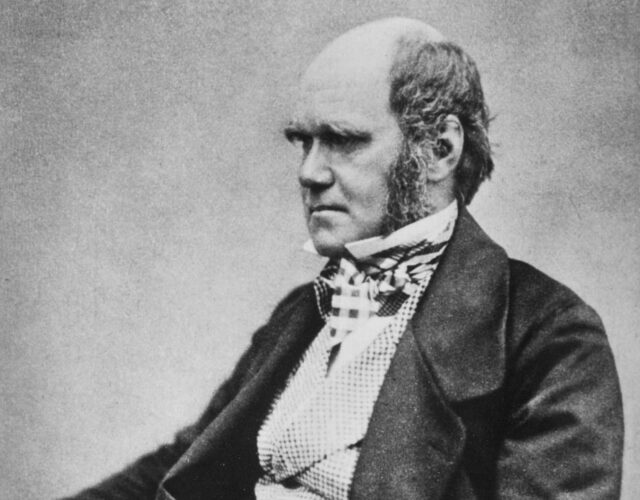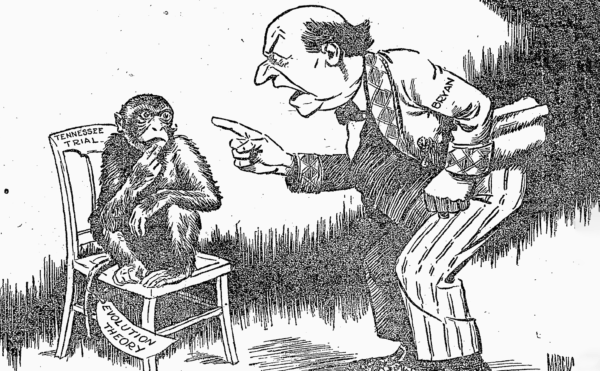Is it serious historical work? Respectable gossip? Blatantly prying into people’s lives? Retro-diagnosing historical celebrities like Darwin and Lincoln and Hitler and Poe is all of the above and more.
About The Disappearing Spoon
The Science History Institute has teamed up with New York Times best-selling author Sam Kean to bring a second history of science podcast to our listeners. The Disappearing Spoon tells little-known stories from our scientific past—from the shocking way the smallpox vaccine was transported around the world to why we don’t have a birth control pill for men. These topsy-turvy science tales, some of which have never made it into history books, are surprisingly powerful and insightful.
Credits
Host: Sam Kean
Senior Producer: Mariel Carr
Producer: Rigoberto Hernandez
Audio Engineer: Jonathan Pfeffer
Transcript
Did you know Charles Darwin suffered from the disease lupus? He suffered from narcolepsy, too. Plus middle-ear damage—pigeon allergies—agoraphobia—chronic fatigue syndrome—an adrenal-gland tumor—Chagas disease—and something called smoldering hepatitis.
At least that’s what modern-day medical sleuths want you to believe. These sleuths are mostly doctors and medical historians. And they’ve published scores of papers over the years trying to retroactively diagnose Charles Darwin with every one of those ailments. Their goal was to try and solve the mystery of why the father of modern biology was so sickly during his lifetime.
You see, Darwin did suffer chronic poor health. His symptoms included boils, fainting fits, heart flutters, numb fingers, insomnia, migraines, dizziness, eczema, and what he called “fiery spokes and dark clouds” that hovered before his eyes.
The strangest symptom was a ringing in his ears, after which—like thunder follows lightning—Darwin always passed horrendous gas. But above all, Darwin barfed. He barfed after breakfast, after lunch, after teatime—whenever—and he kept going until he was dry heaving. In peak form he vomited twenty times an hour. He once vomited twenty-seven days running.
Oddly, mental exertion always made the nausea and gas worse. And even Darwin, who was the most intellectually creative biologist ever, could make no sense of this. “What thought has to do with digesting roast beef,” he once sighed, “I cannot say.”
But modern-day doctors and medical historians think they can say. They think they can diagnose Darwin at a remove of 150 years. But as we’ll see, their track record—not only for Darwin but for Hitler and Lincoln and many more historical celebrities—is dubious at best, and outright dangerous at worst.
Poor health upended Darwin’s entire existence. It often prevented him from attending scientific conferences or even visiting other people’s homes, for fear of fouling their privies. He claimed he never wrote for more than twenty minutes without a stabbing pain somewhere. And he missed several cumulative years of work with various ailments. He even grew out his famous beard partly to soothe the itchy eczema that plagued his face.
Something, then, was clearly wrong with Darwin. But nailing down exactly what has proved a mug’s game. That list of potential diagnoses I read at the start of the episode is almost comical in its range. It veers from autoimmune diseases to viral infections to cancer to mental disorders and beyond.
Part of the problem in retrodiagnosing Darwin is that it’s not clear which of his long list of symptoms are important and which are red herrings. Or perhaps he suffered from multiple afflictions at once. The truth is, no one really knows what Charles Darwin suffered from. And unless new historical evidence comes to light, we likely never will. But that hasn’t stopped doctors and historians from taking a fresh stab every few years.
And Darwin is hardly alone in being put under a medical microscope. There’s a veritable industry out there of people trying to pin diseases and disorders on historical celebrities.
Frederick Chopin was posthumously diagnosed with cystic fibrosis. Fyodor Dostoyevsky with epilepsy. Edgar Allen Poe with rabies. Jane Austen with adult chicken pox. Vlad the Impaler with porphyria. John F. Kennedy with Addison’s disease. Alexander the Great with Ebola, of all things.
Nor have scholars shied away from psychological disorders. Vincent van Gogh has seemingly been diagnosed with half the DSM. I’ve even seen fictional characters analyzed. Doctors have confidently diagnosed Ebenezer Scrooge with OCD. Sherlock Holmes got diagnosed with autism. And Darth Vader? Borderline personality disorder. Actually, that last one’s not so bad.
Many psychologists also play a variation of this game. Instead of diagnosing figures from history, they sometimes diagnose prominent figures from afar in their own lifetimes—especially politicians. But their track record is no less spotty.
The most egregious example of dumb diagnoses involves Adolf Hitler. During World War II, U.S. intelligence was handled by the OSS, or Office of Strategic Services. They were the chaotic, freewheeling predecessor of the CIA.
Now, the OSS commissioned multiple reports on Adolf Hitler’s mental state. And long passages of them read like a parody of Freudian psychobabble. One analyst speculated that Hitler was erotically attracted to his mother and feared that his father would castrate him. Why? Because he claimed that Hitler, “must have discovered his parents during intercourse [once],” despite there being zero evidence for this ever happening.
The analyst then concluded that—and I apologize in advance for this image— Hitler must “derive sexual gratification from the act of having a woman urinate or defecate on him.” Again, there’s zero evidence for this. Even worse, though, the analyst then links this bogus idea to Hitler’s hatred for Jews.
He claimed that Hitler’s hatred grew directly from his shame over his scatological fetishes. In short, the analyst said that Hitler hated how unclean his desires made him feel, then somehow projected that self-loathing onto the Jewish people. Hence the Holocaust.
In addition to being ridiculous logic, conclusions like this ignore the political, social, and historical context that fueled Hitler’s rise to power. It’s an absurd simplification. In this analyst’s view, one pervert comes to power, and the Final Solution is the inevitable result. Utter hogwash.
But this idiocy didn’t stop the OSS from acting on this, quote-unquote, “intelligence.” One of the OSS’s most colorful characters was Stanley Lovell. Lovell was basically a real-life version of Q from the James Bond franchise. His job consisted of puttering around in a lab and thinking up cool spy gadgets.
To take a few examples, Lovell and his labmates developed bombs that looked like mollusks to attach to ships. They crafted shoes with secret cavities to conceal documents. They invented pencils and cigarettes that shot bullets. They even devised an explosive powder that had the consistency of flour and that could be mixed with water and even baked into biscuits and nibbled on without any danger. Only when ignited with a fuse did it explode.
Still, Lovell bought completely into the Freudian nonsense about Hitler. Lovell declared to the OSS chief that Hitler straddled, quote, the “male/female gender line” and might therefore be pushed from one to the other. Accordingly, Lovell isolated some feminine hormones from animal products to give to Hitler. He decided the best way to deliver them would be injecting the hormones into beets and carrots in Hitler’s vegetable garden.
Overall, Lovell hoped that Hitler would eat the tainted vegetables and experience several physiological changes. That his breasts would swell, that his mustache would fall out, that his voice would rise to a soprano register. Supposedly this would be so humiliating that Hitler would kill himself.
I hope I don’t have to point out how dumb this all is. But Lovell’s plan got far enough along to where he actually bribed one of Hitler’s gardeners and handed the hormones over. But ultimately nothing came of the plot. As Lovell later admitted, “I can only assume that the gardener took our money and threw the syringes and medications into the nearest thicket.”
Despite such howlers, psychologists continued to scrutinize political leaders from afar over the next few decades. In 1964, Fact magazine polled nearly 1,200 psychiatrists about Republican presidential nominee Barry Goldwater. The resulting story claimed that that the psychiatrists found Goldwater mentally “unfit” for the White House.
Goldwater later sued the magazine for libel and won. The fiasco led the American Psychological Association to institute the so-called Goldwater Rule. This rule ethically bars psychologists from diagnosing prominent figures unless they’ve personally examined them during a therapy session.
Not that the rule has stopped the practice. As American politics has gotten more heated and nasty over the past two decades, many mental-health professionals have violated the rule and weighed in on the mental fitness of Donald Trump, Joe Biden, and others. It never stops.
Some psychologists argue that they can’t help themselves. They see potential political crises looming, and think that stopping these crises should override the Goldwater Rule.
Meanwhile, defenders of the rule argue that weighing in on political matters makes mental-health workers look like partisan hacks. This undermines their credibility.
Worse, demanding that someone step down from office inadvertently promotes the stereotype that mental disorders are terrible, shameful afflictions. It also implicitly pushes the idea that people with mental disorders cannot possibly do their jobs.
Diagnosing people from afar with mental disorders is all the more dangerous because mental disorders are highly dependent on culture and can shift from one era to the next. As a stark example of this, consider one Soviet psychiatrist during the 1980s.
This psychiatrist was convinced that the new Soviet premier Mikhail Gorbachev was obviously mentally ill. After what else could explain the radical reforms he was pushing through in the waning days of the Soviet empire? Didn’t he know he was harming the strongest, most powerful nation on Earth? He was clearly psychopathic.
Only after the Soviet Union collapsed a few years later did the psychiatrist realize that she was the one with a skewed perspective.
Again, psychologists say they diagnose politicians from afar to help avert potential crises. But with Darwin and others, the motivations for retrodiagnosing them aren’t so clear.
The diagnoses probably stem in part from of our obsession with celebrities. It’s respectable gossip. It’s also partly a pedantic impulse to know every last thing about a famous person’s life.
A more important question, however, is what insight doctors and historians are hoping to gain. If we could prove that artist x or king y really did have such-and-such an ailment, how much would we really learn?
In some cases, arguably a lot. Take Akhenaten, an Egyptian pharaoh from around 1300 BC.
Akhenaten is best known today as the father of King Tut and husband of Queen Nefertiti. But his life has fascinated Egyptologists for centuries. Amid fierce opposition, Akhenaten remade Egypt society top to bottom. Most importantly, he instituted radical new religious practices into an ultraconservative society. Some scholars have called him history’s first monotheist for his elevation of the Egyptian sun god above all other deities.
Akhenaten also changed Egyptian art. In murals and reliefs from Akhenaten’s time, the birds, fish, hunting game, and flowers start to look realistic for the first time. It’s a powerful new style of artistic achievement.
But other art from this era looks bizarre—even alien. Especially depictions of Akhenaten and his family.
In statues and reliefs, Akhenaten’s face and body often appear grotesque and distorted. Archaeologists describing these portrayals sometimes sound like crude carnival barkers. One promises you’ll “recoil from this epitome of physical repulsiveness.” Another calls him a “humanoid praying mantis.”
These archaeologists were probably trying to be provocative, but other archaeologists have noticed odd traits as well—an almond-shaped head, spidery arms, chicken legs with backwards-bending knees, Botox lips, a concave chest, a pendulous potbelly, and on and on. These works are the anti-David, the anti–Venus de Milo, of art history
These depictions are even stranger when you consider that Akhenaten is the pharaoh. He can have himself portrayed however he wants—as a mighty Achilles, or beautiful Adonis. Yet he chose to have himself look like this—look bizarre and alien. Why?
Scratching their heads over this, some archaeologists have suggested that Akhenaten perhaps suffered from a genetic disorder, some of which can produce unusual body shapes.
And frankly, a genetic disorder isn’t a bad guess. Incestuous relationships often produce offspring with birth defects, and there was plenty of incest in pharaonic lines. But however suggestive, these diagnoses suffered from a dearth of evidence.
Some clarity finally arrived in 2007, when the Egyptian government allowed scientists to withdraw DNA from five generations of royal mummies, including Akhenaten. When combined with CT scans of the corpses, this genetic work helped scientists investigate what if any disorders Akhenaten might have suffered from.
Overall, the study turned up no major defects in Akhenaten or his family. This implies that the Egyptian royals looked like normal people. That in turn means that portraits of Akhenaten—which sure don’t look normal—probably didn’t strive for realism. They were probably propaganda. Akhenaten apparently decided that his status as pharaoh lifted him so far above the normal human rabble that he had to inhabit a new type of body in public portraiture. Some of Akhenaten’s strange features, like a distended belly, also call to mind fertility deities. So perhaps he wanted to portray himself as the womb of Egypt’s well-being.
Overall, then, learning more about the medical status of Akhenaten has shed genuine light on his era’s political and artistic practices. Pretty cool stuff.
In other cases, however, the value of retrodiagnoses is far less clear. Multiple doctors and historians have speculated that Abraham Lincoln had Marfan’s syndrome. That’s partly because Lincoln’s tall, gaunt physique and spidery limbs look classically Marfan.
But let’s say that geneticists extracted some Lincoln DNA and tested it. They could easily do so, from one of the bloody artifacts that were saved from the night Lincoln was shot. And let’s say that the DNA proves Lincoln had Marfan syndrome. So what. Would knowing this really illuminate Lincoln the man? Would we really understand anything more about his era or the decisions he made if we could diagnose him 150 years after his death?
And in Lincoln’s case, the medical sleuths would at least have a clear hypothesis to refute or confirm. Most cases of attempted diagnoses resemble Darwin’s case, where there’s a constellation of symptoms and we don’t know which are important and which aren’t.
And the farther back you go, the harder things are. In classical times, symptoms were sometimes recorded dozens or even hundreds of years after the person died, making them as much legend as fact. There’s no guarantee the symptoms were recorded accurately, either, especially if there wasn’t a doctor around.
There are also ethical concerns about scrutinizing people’s medical histories. Some retrodiagnosers have argued that historians already scour people’s diaries and letters, and that examining medical records or taking genetic samples simply extends this license a little.
But the analogy doesn’t quite hold, especially with genetics. That’s because DNA can reveal things that even the person in question didn’t know. Perhaps that’s not so terrible if they’re safely dead. But living descendants might not appreciate their health history being outed.
Now, pointing out the flaws in the field of retrodiagnosing will almost certainly not curb the practice. New papers appear all the time. Some brave souls even extrapolate from the diagnoses to make sweeping counterfactual claims. They argue that such-and-such an illness explains the genesis of a war or the production of an artistic masterpiece. Heck, I’ve even done it myself. Remember my story about Claude Monet and his cataracts?
And honestly, unlike in psychology, there’s little downside to speculating about a historical celebrity’s health. So a Goldwater rule that bans retrodiagnosing people probably isn’t in order. But a little humility might be. The mystery of what ailed Darwin and so many others is one we’ll likely have to live with forever.




